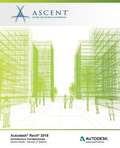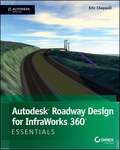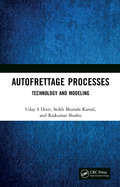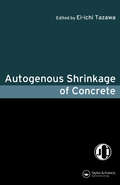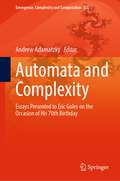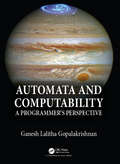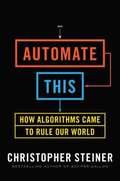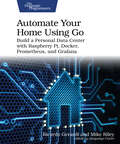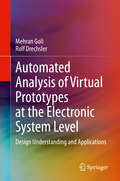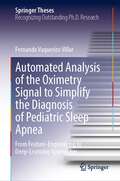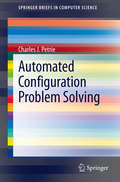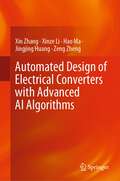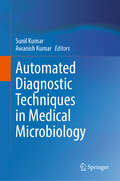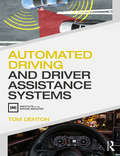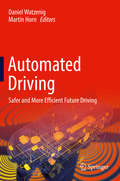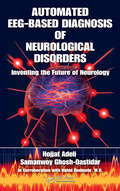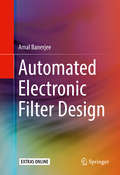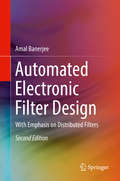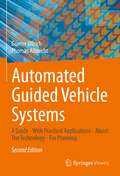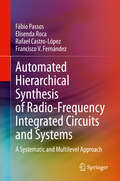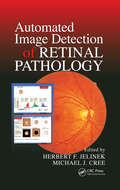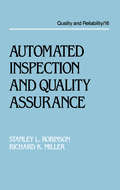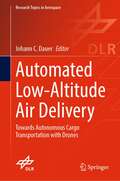- Table View
- List View
Autodesk Revit 2018: Architecture Fundamentals
by ASCENT - Center for Technical Knowledge<p>The Autodesk Revit software is a powerful Building Information Modeling (BIM) program that works the way architects think. The program streamlines the design process through the use of a central 3D model, where changes made in one view update across all views and on the printable sheets. <p>This student guide is designed to teach you the Autodesk Revit functionality as you would work with it throughout the design process. You begin by learning about the user interface and basic drawing, editing, and viewing tools. Then you learn design development tools including how to model walls, doors, windows, floors, ceilings, stairs and more. Finally, you learn the processes that take the model to the construction documentation phase. <p>Since building projects are extremely complex, the Autodesk Revit software is also complex. The objective of the Autodesk(R) Revit(R) 2018 Architecture: Fundamentals student guide is to enable students to create full 3D architectural project models and set them up in working drawings. This student guide focuses on basic tools that the majority of users need. <p>Topics Covered: <p> <li>Understanding the purpose of Building Information Management (BIM) and how it is applied in the Autodesk Revit software. <li>Navigating the Autodesk Revit workspace and interface. <li>Working with the basic drawing and editing tools. <li>Creating Levels and Grids as datum elements for the model. <li>Creating a 3D building model with walls, curtain walls, windows, and doors. <li>Adding floors, ceilings, and roofs to the building model. <li>Creating component-based and custom stairs. <li>Adding component features, such as furniture and equipment. <li>Setting up sheets for plotting with text, dimensions, details, tags, and schedules. <li>Creating details.</li> <p> <p>Prerequisites: <p> <li>An understanding of architectural terminology is an asset.</li>
Autodesk Roadway Design for InfraWorks 360 Essentials
by Eric ChappellLearn the fundamentals of Roadway Design for InfraWorks and InfraWorks 360Autodesk Roadway Design for InfraWorks 360 Essentials offers engineers a hands-on guide that includes straightforward explanations and real-world exercises to demonstrate the software's features and functions. This indispensible book is filled with compelling screenshots that illustrate the steps needed to get up to speed with InfraWorks and InfraWorks 360, both of which give users the power to accelerate the roadway design process and streamline decision making. The book offers specific guidance for creating new designs, and includes information on how to best use the powerful module-specific tools and functions, such as intersection optimization and sightline analysis for safety.Autodesk Roadway Design for InfraWorks 360 Essentials introduces users to the Roadway Design interface and shows how to combine 2D CAD, GIS, raster, and 3D models, including those created with Autodesk AutoCAD Civil 3D civil engineering software. The resource is designed so users can download starting and ending files for the exercises, making it easy to go anywhere in the book and compare results with the professionals.Offers a how-to guide for accessing the exercises and task-based tutorials that will allow users to quickly become productive with the InfraWorks' roadway software moduleReveals the basics for creating compelling simulations and visualizationsShows how to store, manage, and share roadway design modelsTeaches how to access the software's unique design toolsAutodesk Roadway Design for InfraWorks 360 Essentials is the one guide that offers the key to unlocking the potential of powerful design and collaboration software.
Autofrettage Processes: Technology and Modelling
by Rajkumar Shufen Uday Dixit Seikh KamalAutofrettage Processes: Technology and Modeling deals with the technology and modeling of autofrettage processes, explaining the subject in a lucid manner. It highlights how the theory of plasticity and finite element modeling are applied in the modeling of autofrettage processes. Aimed at senior students of mechanical, production, automobile, and chemical engineering, it has the potential to directly benefit practicing engineers and industrials, owing to the inclusion of topics like thermal autofrettage. Key Features: Provides a general introduction to autofrettage Covers the application of theory of plasticity and finite element modeling of autofrettage processes Offers exposure to newer autofrettage processes that to date have not been implemented in industries, along with useful practical data
Autogenous Shrinkage of Concrete: Proceedings Of The International Workshop Organized By Jci (japan Concrete Institute)
by Ei-Ichi TazawaThis book forms the proceedings of a workshop held in Hiroshima in June 1998 and derive from the work of a Technical Committee of the Japan Concrete Institute. Topics include test and prediction methods, the science of autogenous shrinkage, strain and stress, and consequent design concerns.
Automata and Complexity: Essays Presented to Eric Goles on the Occasion of His 70th Birthday (Emergence, Complexity and Computation #42)
by Andrew AdamatzkyThis book commemorates Eric Goles’s achievements in science and engineering. Eric Goles is one of the world leaders in the field of automata and complexity. His groundbreaking discoveries are in the theory and analysis of complex systems, particularly in the field of discrete systems dynamics such as neural networks, automata networks, majority networks, bootstrap percolation models, cellular automata, computational complexity theory, discrete mathematics, and theoretical computer science. Topics include cellular automata, complex networks, models of computation, expansive systems, sandpile automata, Penrose tilings, Boolean automata, models of infection, Fibonacci trees, dominos, reversible automata, and fungal automata. The chapters are authored by world leaders in computer science, physics, mathematics, and engineering. The book will be a pleasure to explore for readers from all walks of life, from undergraduate students to university professors, from mathematicians, computer scientists, and engineers to chemists and biologists.
Automata and Computability: A Programmer's Perspective
by Ganesh GopalakrishnanAutomata and Computability is a class-tested textbook which provides a comprehensive and accessible introduction to the theory of automata and computation. The author uses illustrations, engaging examples, and historical remarks to make the material interesting and relevant for students. It incorporates modern/handy ideas, such as derivative-based parsing and a Lambda reducer showing the universality of Lambda calculus. The book also shows how to sculpt automata by making the regular language conversion pipeline available through a simple command interface. A Jupyter notebook will accompany the book to feature code, YouTube videos, and other supplements to assist instructors and studentsFeatures Uses illustrations, engaging examples, and historical remarks to make the material accessible Incorporates modern/handy ideas, such as derivative-based parsing and a Lambda reducer showing the universality of Lambda calculus Shows how to "sculpt" automata by making the regular language conversion pipeline available through simple command interface Uses a mini functional programming (FP) notation consisting of lambdas, maps, filters, and set comprehension (supported in Python) to convey math through PL constructs that are succinct and resemble math Provides all concepts are encoded in a compact Functional Programming code that will tesselate with Latex markup and Jupyter widgets in a document that will accompany the books. Students can run code effortlessly href="https://github.com/ganeshutah/Jove.git/"here.
Automate This
by Christopher SteinerHow the rise of computerized decision-making affects every aspect of business and daily life The bot takeover began with high frequency trading on Wall Street, and from there it spread to all manners of high-level tasks--such as diagnosing illnesses or interpreting legal documents. There is no realm of human endeavor safe from algorithms that employ speed, precision and nuance. In this fascinating book, Steiner tells the story of how algorithms took over and shows why the "bot revolution" is about to spill into every aspect of our lives. We meet bots that are driving cars, penning haikus, and writing music mistaken for Bach's. They listen in on customer service calls and figure out what Iran would do in the event of a nuclear standoff. On Wall Street, pre-programmed algorithmic deals are executed by machines faster than any human could--leaving human investors at a severe disadvantage. But what will the world look like when algorithms control our hospitals, our roads, and our national security? Is a stock market controlled by high-speed trading bots worth investing in? And what role will be left for doctors, lawyers, writers, truck drivers, and many others?
Automate Your Home Using Go
by Mike Riley Ricardo GerardiTake control of your home and your data with the power of the Go programming language. Build extraordinary and robust home automation solutions that rival much more expensive, closed commercial alternatives, using the same tools found in high-end enterprise computing environments. Best-selling Pragmatic Bookshelf authors Ricardo Gerardi and Mike Riley show how you can use inexpensive Raspberry Pi hardware and excellent, open source Go-based software tools like Prometheus and Grafana to create your own personal data center. Using the step-by-step examples in the book, build useful home automation projects that you can use as a blueprint for your own custom projects. With just a Raspberry Pi and the Go programming language, build your own personal data center that coordinates and manages your home automation, leveraging the same high-powered software used by large enterprises. The projects in this book are easy to assemble, no soldering or electrical engineering expertise required. Build a temperature monitor that can send alerts any time defined thresholds are exceeded and report the temperature readings on a time-based series chart. Change the color of lights to visually indicate the current outdoor weather status. Create a networked motion detector that triggers an alert any time motion is detected, such as a door opening or closing, a pet wandering around, or deliveries or visitors arriving on your front porch. Even have these triggers initiate a more complex Go-based automation sequence. Integrate a small, high-resolution camera into a bird feeder that takes excellent, up-close photos whenever a bird perches at the feeder, and broadcasts them to your Discord server where your family and friends can see these wildlife captures in real time. Control your home with hardware you configure, and manage it with Go code that you create and modify any time you want to enhance your home automation capabilities. What You Need: Readers should be familiar with the Go programming language and have working knowledge of Linux. Free, open source Go-based libraries and utilities are available for download from the Internet. Readers will also need a working Raspberry Pi 3+ or higher, and a Pi Pico W microcontroller. Several other inexpensive electronic parts (touch sensors, motion detectors) are also needed for some of the projects. A Philips Hue base lighting system is also needed for the weather monitor project.
Automated Analysis of Virtual Prototypes at the Electronic System Level: Design Understanding and Applications
by Rolf Drechsler Mehran GoliThis book describes a set of SystemC‐based virtual prototype analysis methodologies, including design understanding, verification, security validation, and design space exploration. Readers will gain an overview of the latest research results in the field of Electronic Design Automation (EDA) at the Electronic System Level (ESL). The methodologies discussed enable readers to tackle easily key tasks and applications in the design process.
Automated Analysis of the Oximetry Signal to Simplify the Diagnosis of Pediatric Sleep Apnea: From Feature-Engineering to Deep-Learning Approaches (Springer Theses)
by Fernando Vaquerizo VillarThis book describes the application of novel signal processing algorithms to improve the diagnostic capability of the blood oxygen saturation signal (SpO2) from nocturnal oximetry in the simplification of pediatric obstructive sleep apnea (OSA) diagnosis. For this purpose, 3196 SpO2 recordings from three different databases were analyzed using feature-engineering and deep-learning methodologies. Particularly, three novel feature extraction algorithms (bispectrum, wavelet, and detrended fluctuation analysis), as well as a novel deep-learning architecture based on convolutional neural networks are proposed. The proposed feature-engineering and deep-learning models outperformed conventional features from the oximetry signal, as well as state-of-the-art approaches. On the one hand, this book shows that bispectrum, wavelet, and detrended fluctuation analysis can be used to characterize changes in the SpO2 signal caused by apneic events in pediatric subjects. On the other hand, it demonstrates that deep-learning algorithms can learn complex features from oximetry dynamics that allow to enhance the diagnostic capability of nocturnal oximetry in the context of childhood OSA. All in all, this book offers a comprehensive and timely guide to the use of signal processing and AI methods in the diagnosis of pediatric OSA, including novel methodological insights concerning the automated analysis of the oximetry signal. It also discusses some open questions for future research.
Automated Configuration Problem Solving (SpringerBriefs in Computer Science)
by Charles J. PetrieAutomated Configuration has long been the subject of intensive research, especially in Artificial Intelligence. It is a pervasive problem to be solved, and it is a good test of various knowledge representation and reasoning techniques. The problem shows up in applications such as various electrical circuit design, utility computing and even concurrent engineering. Automated Configuration Problem Solving defines the ubiquitous problem, illustrates the various solution techniques, and includes a survey using these techniques from the mid-70's until the mid-90's. During this time, various general approaches were developed, and then become more specialized. This book covers the development of the general problem solving techniques for automated configuration, which are based on both published academic work and patents.
Automated Design of Electrical Converters with Advanced AI Algorithms
by Xin Zhang Hao Ma Jingjing Huang Xinze Li Zeng ZhengA power converter is a device used in electrical engineering, power engineering, and the electric power sector to convert electric energy from one form to another, such as converting between AC and DC, changing voltage or frequency, or a combination of these. It is used in a variety of applications, such as industrial drives, power supply, energy generating equipment, consumer goods, electrical vehicles/aeroplanes/ships, smart grids and more.This book will open a door for engineers to design the power converters via the artificial intelligence (AI) method. It begins by reviewing current AI technology in power converters. The book then introduces customized AI algorithms for power converters that take into account the particular characteristics of power converters. The book then presents a set of AI-based design methodologies for power devices, including DC/DC converters, resonant DC/DC converters, bidirectional DC/DC converters, DC/AC inverters, and AC/DC rectifiers. This is the first book to cover all you need to know about using AI to create power converters, including a literature review, algorithm, and circuit design.
Automated Diagnostic Techniques in Medical Microbiology
by Sunil Kumar Awanish KumarThis book will explore the knowledge of current diagnostic automation techniques applied in the field of clinical microbiology, tropical diseases, POCT, etc. There is no such type of book related to this topic. This book will help clinicians, microbiologists, and researchers to make diagnostic algorithms for infectious diseases and help them in early diagnosis. Automation in clinical microbiology has revolutionized routine practice in diagnostic cum research in medical microbiology. This book covers the recent updates and advances in diagnostic microbiology and provides new techniques related to Genomic, Proteomic, and metabolomics in microbiology. This book will intensely discuss the new and innovative automation techniques available for diagnosis in the microbiology laboratory. This book is more focused on automation techniques, which are used in the early detection of infectious diseases even caused by rare microorganisms. Furthermore, this book has complied with the chapters that provide insights to readers with comprehensive and usable knowledge on automation techniques in diagnostic microbiology.
Automated Driving and Driver Assistance Systems
by Tom DentonAutomated vehicles are set to transform the world. Automated driving vehicles are here already and undergoing serious testing in several countries around the world. This book explains the technologies in language that is easy to understand and accessible to all readers. It covers the subject from several angles but in particular shows the links to existing ADAS technologies already in use in all modern vehicles. There is a lot of hype in the media at the moment about autonomous or driverless cars, and while some manufacturers expect to have vehicles available from 2020, they will not soon take over and it will be some time before they are commonplace. However, it is very important to be ready for the huge change of direction that automated driving will take. This is the first book of its type available and complements Tom Denton's other books.
Automated Driving: Safer and More Efficient Future Driving
by Martin Horn Daniel WatzenigThe main topics of this book include advanced control, cognitive data processing, high performance computing, functional safety, and comprehensive validation. These topics are seen as technological bricks to drive forward automated driving.The current state of the art of automated vehicle research, development and innovation is given. The book also addresses industry-driven roadmaps for major new technology advances as well as collaborative European initiatives supporting the evolvement of automated driving. Various examples highlight the state of development of automated driving as well as the way forward.The book will be of interest to academics and researchers within engineering, graduate students, automotive engineers at OEMs and suppliers, ICT and software engineers, managers, and other decision-makers.
Automated EEG-Based Diagnosis of Neurological Disorders: Inventing the Future of Neurology
by Hojjat Adeli Samanwoy Ghosh-DastidarBased on the authors' groundbreaking research, Automated EEG-Based Diagnosis of Neurological Disorders: Inventing the Future of Neurology presents a research ideology, a novel multi-paradigm methodology, and advanced computational models for the automated EEG-based diagnosis of neurological disorders. It is based on the ingenious integration of thr
Automated Electronic Filter Design: With Emphasis On Distributed Filters
by Amal BanerjeeThis book describes a novel, efficient and powerful scheme for designing and evaluating the performance characteristics of any electronic filter designed with predefined specifications. The author explains techniques that enable readers to eliminate complicated manual, and thus error-prone and time-consuming, steps of traditional design techniques. The presentation includes demonstration of efficient automation, using an ANSI C language program, which accepts any filter design specification (e. g. Chebyschev low-pass filter, cut-off frequency, pass-band ripple etc. ) as input and generates as output a SPICE(Simulation Program with Integrated Circuit Emphasis) format netlist. Readers then can use this netlist to run simulations with any version of the popular SPICE simulator, increasing accuracy of the final results, without violating any of the key principles of the traditional design scheme.
Automated Electronic Filter Design: With Emphasis on Distributed Filters
by Amal BanerjeeThis book describes a novel, efficient and powerful scheme for designing and evaluating the performance characteristics of any electronic filter designed with predefined specifications. The author explains techniques that enable readers to eliminate complicated manual, and thus error-prone and time-consuming, steps of traditional design techniques. The presentation includes demonstration of efficient automation, using an ANSI C language program, which accepts any filter design specification (e. g. Chebyschev low-pass filter, cut-off frequency, pass-band ripple etc. ) as input and generates as output a SPICE(Simulation Program with Integrated Circuit Emphasis) format netlist. Readers then can use this netlist to run simulations with any version of the popular SPICE simulator, increasing accuracy of the final results, without violating any of the key principles of the traditional design scheme.
Automated Guided Vehicle Systems: A Guide - With Practical Applications - About The Technology - For Planning
by Günter Ullrich Thomas AlbrechtThis professional book provides a comprehensive overview of the modern organisational tool of intralogistics. Automated Guided Vehicle Systems (AGV Systems) are floor-based systems that are used internally inside and/or outside of buildings. Since the mid-1990s, AGV Systems have successfully penetrated almost all sectors of industry and many public areas, such as hospitals. The technological standards of all AGV-relevant components and functions are explained and numerous practical examples, e.g. from the automotive, electrical and food industries, are presented. Another focus is the practical planning of such intralogistics systems based on the VDI guidelines, including hints and tips for successful project management when introducing an AGV System. This edition has been completely revised, restructured and reflects the rapid developments in technology and markets.
Automated Guided Vehicle Systems: A Primer with Practical Applications
by Günter UllrichThis primer is directed at experts and practitioners in intralogistics who are concerned with optimizing material flows. The presentation is comprehensive covering both, practical and theoretical aspects with a moderate degree of specialization, using clear and concise language. Areas of operation as well as technical standards of all relevant components and functions are described. Recent developments in technology and in the markets are taken into account. The goal of this book is to further stronger use of automated guided transport systems and the enhancement of their future performance.
Automated Hierarchical Synthesis of Radio-Frequency Integrated Circuits and Systems: A Systematic and Multilevel Approach
by Elisenda Roca Francisco V. Fernández Fábio Passos Rafael Castro-LópezThis book describes a new design methodology that allows optimization-based synthesis of RF systems in a hierarchical multilevel approach, in which the system is designed in a bottom-up fashion, from the device level up to the (sub)system level. At each level of the design hierarchy, the authors discuss methods that increase the design robustness and increase the accuracy and efficiency of the simulations. The methodology described enables circuit sizing and layout in a complete and automated integrated manner, achieving optimized designs in significantly less time than with traditional approaches.
Automated Image Detection of Retinal Pathology
by Herbert Jelinek Michael J. CreeDiscusses the Effect of Automated Assessment Programs on Health Care ProvisionDiabetes is approaching pandemic numbers, and as an associated complication, diabetic retinopathy is also on the rise. Much about the computer-based diagnosis of this intricate illness has been discovered and proven effective in research labs. But, unfortunately, many of
Automated Inspection and Quality Assurance (Quality And Reliability Ser. #16)
by Stanley L. Robinson Richard Kendall MillerNew concepts for gaging, inspection, checking, machine vision, and robotic testing. Includes guidelines for installing complex electronic and computerized systems and a directory of commercially availalbe computer software, as well as distributors' names and addresses. Annotation copyright Book News
Automated Low-Altitude Air Delivery: Towards Autonomous Cargo Transportation with Drones (Research Topics in Aerospace)
by Johann C. DauerThis book investigates Unmanned Aircraft Systems (UAS) with a payload capacity of one metric ton for transportation. The authors provide a large variety of perspectives–from economics to technical realization. With the focus on such heavy-lift cargo UAS, the authors consider recently established methods for approval and certification, which they expect to be disruptive for unmanned aviation. In particular, the Specific Operations Risk Assessment (SORA) and its impact on the presented technological solutions and operational concepts are studied. Starting with the assumption of an operation over sparsely populated areas and below common air traffic, diverse measures to further reduce operational risks are proposed. Operational concepts derived from logistics use-cases set the context for an in-depth analysis including aircraft and system design, safe autonomy as well as airspace integration and datalinks. Results from simulations and technology demonstrations are presented as a proof of concept for solutions proposed in this book.
Automated Planning and Acting
by Malik GhallabAutonomous AI systems need complex computational techniques for planning and performing actions. Planning and acting require significant deliberation because an intelligent system must coordinate and integrate these activities in order to act effectively in the real world. This book presents a comprehensive paradigm of planning and acting using the most recent and advanced automated-planning techniques. It explains the computational deliberation capabilities that allow an actor, whether physical or virtual, to reason about its actions, choose them, organize them purposefully, and act deliberately to achieve an objective. Useful for students, practitioners, and researchers, this book covers state-of-the-art planning techniques, acting techniques, and their integration which will allow readers to design intelligent systems that are able to act effectively in the real world.
